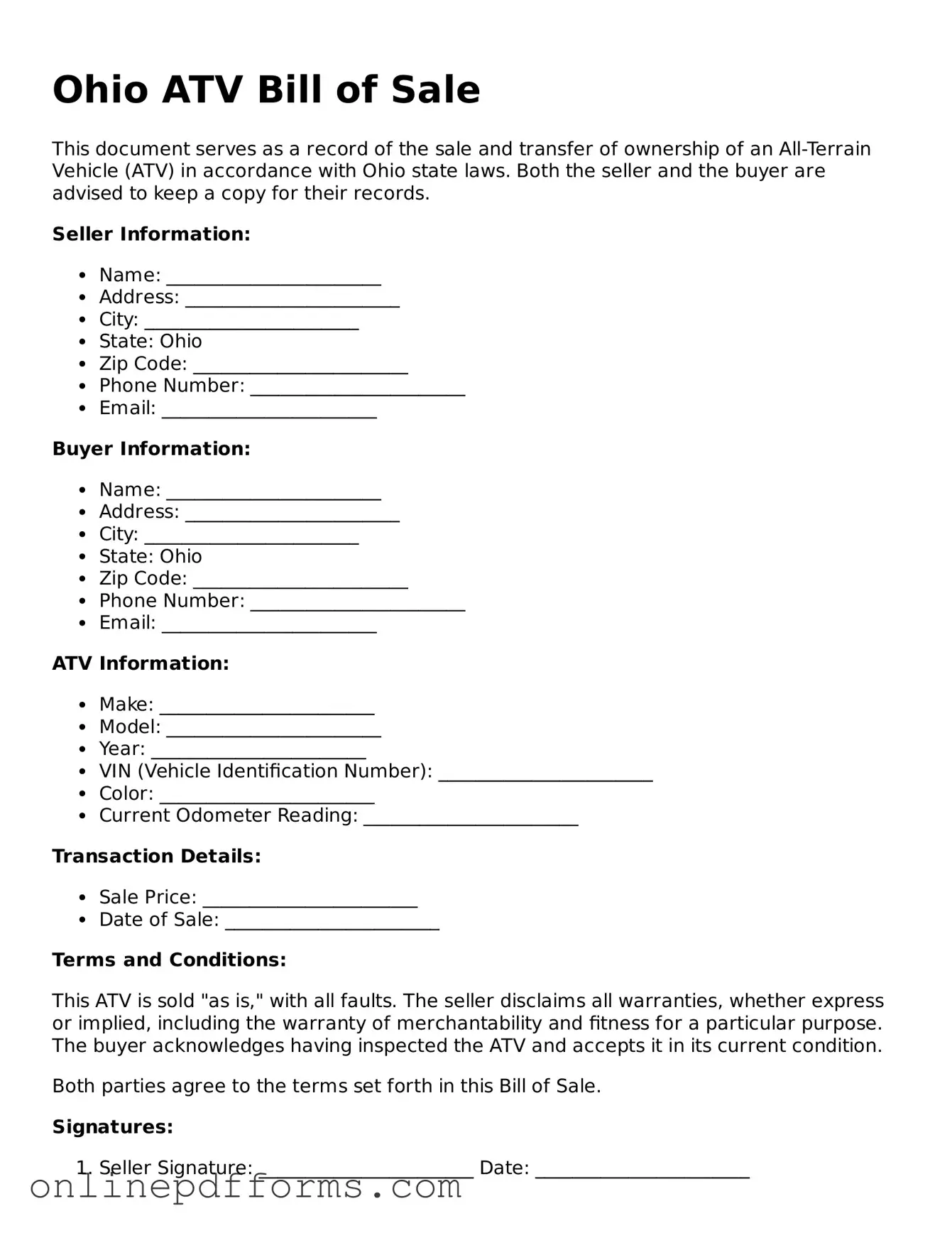The Ohio ATV Bill of Sale form is similar to the general Vehicle Bill of Sale. Both documents serve as proof of transfer of ownership from one party to another. They include essential details such as the buyer's and seller's names, addresses, and signatures. Additionally, both forms often require information about the vehicle, including its make, model, year, and identification number. This ensures that the transaction is clear and legally binding, providing protection for both parties involved.
Another document that shares similarities is the Motorcycle Bill of Sale. Like the ATV Bill of Sale, this form is used to document the sale of a motorcycle, capturing vital information about the buyer, seller, and the motorcycle itself. Both documents help in establishing a clear chain of ownership and can be useful for registration purposes. They often include similar clauses regarding the condition of the vehicle and any warranties or disclaimers that may apply.
The Boat Bill of Sale is also akin to the Ohio ATV Bill of Sale. This document is utilized when transferring ownership of a boat, and it contains comparable information such as the names and addresses of the parties involved, as well as details about the boat. Just like the ATV Bill of Sale, it serves to protect both the buyer and seller by providing a record of the transaction, which can be important for future registrations and potential disputes.
Additionally, the Snowmobile Bill of Sale shares many features with the ATV Bill of Sale. Both forms are designed to document the sale of recreational vehicles, capturing necessary information about the buyer and seller, as well as the vehicle's specifications. This ensures that the ownership transfer is legally recognized and helps avoid any misunderstandings regarding the sale.
The Trailer Bill of Sale is another document that resembles the Ohio ATV Bill of Sale. It is used when selling or buying a trailer, and it includes essential details such as the buyer's and seller's information, trailer identification numbers, and any relevant sale conditions. Both documents serve the same purpose of confirming the transfer of ownership and providing a record for future reference.
The Personal Watercraft Bill of Sale also has similarities with the ATV Bill of Sale. This form is specifically used for the sale of personal watercraft, such as jet skis. It captures similar information about the buyer, seller, and the watercraft itself, ensuring that the transaction is documented properly. Both documents help facilitate the registration process and protect the rights of both parties involved.
The Farm Equipment Bill of Sale is another related document. This form is used for the sale of agricultural machinery and equipment. Like the ATV Bill of Sale, it includes details about the buyer and seller, as well as a description of the equipment being sold. Both documents provide a clear record of the transaction, which can be important for tax purposes and future ownership verification.
For those considering buying or selling a trailer, understanding the importance of the Trailer Bill of Sale is crucial. This document not only facilitates the transfer of ownership but also outlines essential details such as the trailer's specifications and sale price, ensuring that both parties are protected. To get started with this important paperwork, you can find the Trailer Bill of Sale form at https://pdftemplates.info/trailer-bill-of-sale-form/.
The RV Bill of Sale is also comparable to the Ohio ATV Bill of Sale. This document is used for the sale of recreational vehicles and includes similar information about the buyer, seller, and the RV itself. Both forms help ensure that the ownership transfer is documented and legally recognized, which is crucial for registration and potential future sales.
Finally, the Lease Agreement can be seen as somewhat similar in purpose to the ATV Bill of Sale, though it serves a different function. While the Bill of Sale confirms ownership transfer, a Lease Agreement outlines the terms under which one party can use another party's property. Both documents require clear information about the parties involved and the item in question, ensuring that all terms are understood and agreed upon.
